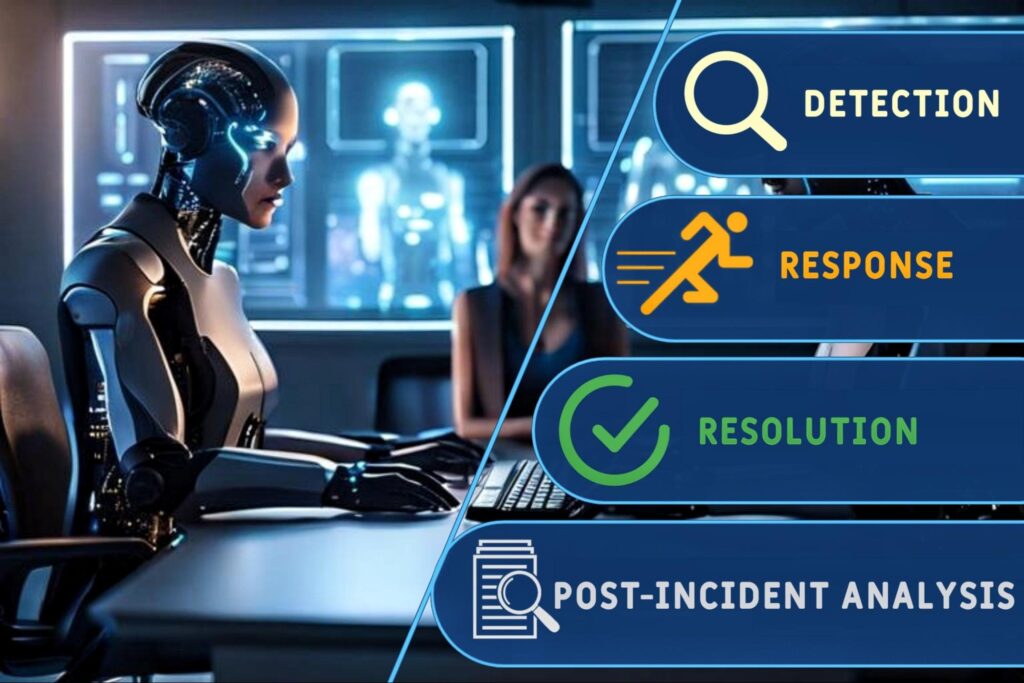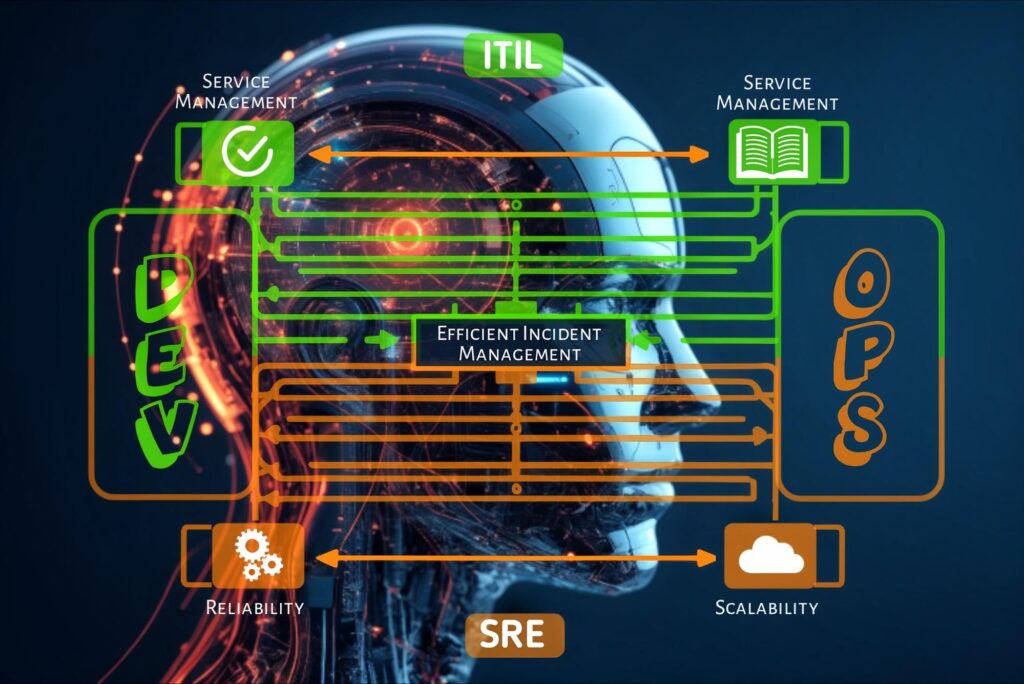DevOps Incident Management Process and Responding to System Failures
 25 March 2024
25 March 2024? Listen to the Summary of this article in Audio
How an organization responds to incidents, determines the impact on customer satisfaction, system reliability, and the bottom line. Effective incident management is not just about fixing problems; it’s about doing so in a way that aligns with the organization’s operational goals and customer needs. This is where DevOps comes into play, integrating development and operations teams to facilitate a more responsive, agile approach to incident management.
The DevOps approach to incident management emphasizes the importance of swift, effective responses to system failures, ensuring that services are restored as quickly as possible and that the same issues are less likely to recur. Incorporating best practices in incident response and leveraging a comprehensive incident management process, DevOps teams can significantly enhance the resilience and reliability of their systems.
This article delves into the intricacies of DevOps Incident Management Process, outlining how organizations can respond to system failures with agility and precision. By embracing a DevOps approach, integrating principles of ITIL (Information Technology Infrastructure Library) and SRE (Site Reliability Engineering), and focusing on continuous improvement, businesses can not only manage incidents more effectively but also improve their overall service management.
Key elements such as forming an adept incident response team, automating the detection and resolution processes, and learning from each incident to prevent future occurrences are central to a successful DevOps incident management strategy. Through this comprehensive guide, we will explore how adopting these practices and focusing on customer satisfaction can lead to a more resilient and efficient operational framework.
DevOps Incident Management Framework
The DevOps Incident Management Framework is a structured approach that enables organizations to manage and resolve incidents efficiently. This framework is supported by a blend of methodologies from DevOps and SRE (Site Reliability Engineering), and it incorporates established frameworks like ITIL (Information Technology Infrastructure Library). It aims to streamline the incident management process, ensuring rapid resolution and minimal impact on business operations. In this section, we delve into the stages of the incident management lifecycle, the integration of ITIL and SRE principles, and how these practices contribute to an effective incident management system.
Stages of Incident Management Lifecycle

The incident management lifecycle comprises several key stages:
- Detection: The initial identification of an issue, often facilitated by monitoring tools that alert the DevOps team to potential problems.
- Response: Once an incident is detected, the incident response team takes immediate action to mitigate the impact on users and system performance.
- Resolution: The team works to resolve the incident, restoring service to its normal state as quickly as possible.
- Post-Incident Analysis: After resolution, a thorough review is conducted to identify the root cause and to document lessons learned.
This lifecycle allows teams to manage incidents effectively, prioritizing rapid response and resolution to maintain high levels of service quality.
ITIL and SRE Foundations
The integration of ITIL and SRE principles provides a robust foundation for DevOps incident management. ITIL offers a comprehensive set of best practices for IT service management, focusing on aligning IT services with business needs. SRE, on the other hand, emphasizes reliability and scalability, advocating for automation and continuous improvement to enhance system resilience.
By combining ITIL’s structured approach to service management with SRE’s focus on engineering and operational excellence, DevOps teams can develop a more efficient and effective incident management process. This blend encourages not only the quick resolution of incidents but also the implementation of strategies to prevent similar incidents in the future.

Building an Effective Incident Response Team
A crucial component of successful incident management is the assembly of a skilled incident response team. This team is responsible for managing the entire incident lifecycle, from detection through to resolution and analysis. Key roles within the team include:
- Incident Manager: Oversees the incident management process, ensuring effective coordination and communication.
- Incident Commander: Leads the technical response to incidents, making critical decisions to resolve the issue.
The incident response team works closely with development and operations teams, leveraging a DevOps and SRE mindset to facilitate efficient incident management. This collaborative approach is essential for responding to incidents quickly and efficiently, minimizing downtime and maintaining customer trust.
Leveraging Incident Management Platforms and Tools
An effective incident management solution requires the right tools. Incident management platforms provide a centralized hub for managing incidents, enabling teams to track, prioritize, and resolve issues systematically. These platforms often feature automated incident response capabilities, which can significantly reduce the mean time to resolution (MTTR) by automating routine tasks and facilitating clear communication throughout the incident.
Automation in incident management not only speeds up the response but also helps in standardizing the approach to incident handling, ensuring consistent and reliable operations management. Additionally, these platforms support continuous improvement by allowing teams to analyze past incidents, identify areas for improvement, and update response playbooks accordingly.
with DevOps Expertise
Best Practices for Incident Detection and Alerting
Effective incident management begins with early detection and accurate alerting. Monitoring systems play a vital role in detecting anomalies that could indicate a system failure. Best practices in this area include:
- Implementing comprehensive monitoring: Covering various aspects of system performance to ensure potential incidents are detected promptly.
- Prioritizing alerts: Based on the severity and impact of the incident, to ensure that response efforts are focused where they are most needed.
- Clear communication: Ensuring alerts provide all necessary information for the response team to act quickly.
Streamlining Incident Response with Automation
In the realm of DevOps incident management, automation stands as a pivotal component in streamlining the incident response process. Automation not only accelerates the resolution of incidents but also ensures consistency and reliability across the incident management lifecycle. By automating repetitive tasks and responses, DevOps teams can focus on more complex problem-solving and strategic activities that require human intervention. This section highlights the benefits of automation, identifies key tools and techniques, and outlines strategies for implementing automation effectively within the incident management framework.
Benefits of Automating Incident Management
Rapid Response: Automation enables immediate action upon detection of an incident, significantly reducing the mean time to detection (MTTD) and mean time to resolution (MTTR). Automated workflows can initiate diagnostics, alert relevant personnel, and even apply predefined fixes to common problems without human intervention.
Consistency and Accuracy: Automated processes eliminate the variability introduced by manual operations, ensuring that incidents are handled consistently and according to the best practices documented in response playbooks.
Scalability: Automation allows DevOps teams to manage incidents across increasingly complex and scalable infrastructure without a proportional increase in human resources.
Tools and Techniques for Incident Management Automation
Incident Detection and Alerting: Advanced monitoring tools and alerting systems can automatically detect system anomalies and trigger alerts, initiating the incident response process without delay.
Automated Incident Response: Incident management platforms often feature automated response capabilities, such as executing predefined scripts to address known issues or automatically escalating incidents based on their severity.
Workflow Automation: Tools like automated workflow managers can guide the incident response process, ensuring that all steps, from initial detection to resolution and review, are executed according to the organization’s protocols.
Communication and Collaboration Tools: Automation tools integrate with communication platforms to ensure that all stakeholders are kept informed throughout the incident management process, facilitating clear and consistent communication.
Implementing Automation in Incident Response
Identify Automatable Tasks: Begin by identifying repetitive or time-consuming tasks within the incident management process that are candidates for automation. This can include incident detection, initial diagnosis, communication, and basic remediation steps.
Select the Right Tools: Choose automation tools that integrate well with your existing incident management platform and support the specific tasks you aim to automate. Consider tools that offer flexibility, scalability, and ease of integration with other systems.
Develop and Test Automation Scripts: Develop automation scripts and workflows for the identified tasks. It’s crucial to thoroughly test these scripts in a controlled environment to ensure they perform as expected without unintended consequences.
Train the Team: Ensure that the incident response team is well-trained in using automation tools and understands the automated processes. This includes knowing how to initiate automated responses, how to intervene manually when necessary, and how to monitor automated activities for anomalies.
Continuous Improvement: Automation is not a set-it-and-forget-it solution. Regularly review and update automated processes based on feedback from incident post-mortems and continuous improvement efforts. This ensures that automation strategies evolve alongside the organization’s infrastructure and incident management practices.
with Tailored Solutions
The Incident Resolution Process and Responding to System Failures
Resolving incidents efficiently and effectively is a cornerstone of DevOps incident management. This process is not only about restoring service but also ensuring that the resolution aligns with best practices and contributes to the overall resilience of the system. Incorporating principles from both DevOps and SRE, the incident resolution process in enterprise incident management involves a comprehensive approach that spans from the initial detection of an incident to implementing a fix and preventing future occurrences. This section delves into strategies for managing and resolving incidents, emphasizing the role of automation, the importance of a structured approach, and the continuous improvement of incident management practices.
Strategic Approach to Incident Resolution
Prioritization Based on Impact and Urgency: Not all incidents are created equal. Efficient incident management involves prioritizing incidents based on their impact on the business and the urgency of resolution. This ensures that resources are allocated effectively to address the most critical issues first.
Collaboration Between Development and Operations Teams: The synergy between development and operations teams is vital for resolving incidents swiftly. A DevOps approach encourages a collaborative environment where knowledge and skills are shared, speeding up the diagnostic and resolution process.
Leveraging Incident Management Platforms: Advanced incident management solutions provide a centralized platform for tracking, managing, and resolving incidents. These platforms facilitate a streamlined approach to incident management, enabling teams to respond to incidents quickly and efficiently.
Problem Management Integration
Effective incident management does not end with resolving the immediate issue. Integrating problem management processes allows teams to analyze incidents to identify and address the underlying root causes. This proactive approach prevents similar incidents from occurring in the future, enhancing the resilience of systems.
Root Cause Analysis (RCA): Conducting a thorough root cause analysis after major incidents helps in identifying the underlying issues that led to the incident. Documenting these findings and implementing corrective actions is crucial for preventing recurrence.
Updating Response Playbooks: Based on insights gained from RCA and continuous improvement efforts, updating response playbooks ensures that the incident response team is equipped with the latest strategies and procedures for handling future incidents.
Automation in Incident Resolution
Automated Incident Response: Incorporating automated incident response tools can significantly reduce the time to resolve incidents. Automated workflows can perform initial diagnostics, apply quick fixes for known issues, and even roll back changes that caused the incident, all without manual intervention.
Continuous Deployment and Integration: Automation extends to the deployment of fixes. Continuous integration and deployment practices enable teams to roll out patches and updates quickly, minimizing downtime and ensuring that the system returns to its operational state as swiftly as possible.
with DevOps Practices
Learning from Incidents: Continuous Improvement
A critical component of DevOps incident management is the emphasis on learning from incidents and leveraging those insights to drive continuous improvement. This approach not only helps in resolving current issues more effectively but also plays a crucial role in preventing future incidents. By analyzing incidents, identifying root causes, and implementing corrective actions, organizations can enhance the resilience and reliability of their systems.

Post-Incident Reviews
Conducting Effective Reviews: Following the resolution of an incident, it’s essential to conduct a thorough review or post-mortem. This involves all stakeholders and focuses on understanding what happened, why it happened, and how similar incidents can be prevented in the future.
Documenting Lessons Learned: The insights gained from the review should be documented clearly and shared across the organization. This documentation serves as a valuable resource for training and guiding future responses to incidents.
Metrics and KPIs for Continuous Improvement
Leveraging Data for Insights: Key performance indicators (KPIs) such as Mean Time to Detect (MTTD), Mean Time to Resolve (MTTR), and incident frequency provide valuable data on the effectiveness of the incident management process. Analyzing these metrics helps identify areas for improvement.
Setting Improvement Goals: Based on the insights gained from metrics and post-incident reviews, organizations should set specific, measurable goals for improving their incident management practices.
The Role of DevOps and SRE in Continuous Improvement
Fostering a Culture of Learning: Both DevOps and SRE emphasize the importance of learning from failures. This culture supports an environment where teams are encouraged to share knowledge and experiences, fostering continuous improvement.
Iterative Improvement: DevOps and SRE principles advocate for small, iterative changes based on feedback and learning. This approach ensures that improvements are manageable and can be quickly implemented without disrupting operations.
Preventing Future Incidents: By focusing on the root cause analysis and leveraging insights from past incidents, DevOps and SRE practices help in developing proactive measures to prevent future incidents. This includes updating response playbooks, improving monitoring and alerting systems, and enhancing system architecture for greater resilience.
Implementing a Centralized Management Solution
Centralizing incident management involves integrating various tools, platforms, and processes into a unified management solution. This centralized approach not only simplifies the incident management process but also enhances the effectiveness of detection, response, and resolution efforts.
Benefits of Centralizing Incident Management
Enhanced Visibility and Control: A centralized platform provides a comprehensive view of all incidents across the organization, allowing teams to prioritize and manage incidents more effectively.
Streamlined Communication: Centralization facilitates clearer communication among all stakeholders involved in incident management, ensuring that everyone is aligned and informed throughout the incident lifecycle.
Improved Efficiency and Productivity: By consolidating tools and processes, organizations can reduce the complexity and overhead associated with managing multiple disparate systems, leading to improved operational efficiency.
Choosing the Right Incident Management Software
Integration Capabilities: Selecting software that seamlessly integrates with existing tools and systems is crucial for ensuring a smooth transition to a centralized model.
Scalability: The chosen solution should be capable of scaling to meet the evolving needs of the organization, accommodating growth in infrastructure and incident volume.
User-Friendliness: A platform that is intuitive and easy to use encourages adoption among team members and stakeholders, ensuring that the benefits of centralization are fully realized.
Conclusion
The journey through the DevOps Incident Management Process underscores a fundamental truth: effective management of system failures is not just about the immediate response but encompasses a holistic approach that includes preparation, resolution, and post-incident analysis aimed at continuous improvement. In the dynamic landscape of IT, incidents are inevitable, but their impact on operations and customer experience can be significantly mitigated through a well-orchestrated incident management strategy.
Moving Forward
Adopting and refining an incident management process in line with the practices and principles discussed is an ongoing journey, one that requires commitment, flexibility, and a willingness to learn. Organizations that embrace these principles, continuously seeking to improve their incident management capabilities, position themselves to not only handle system failures more adeptly but also to drive operational improvements that can prevent incidents before they occur.
with a Custom Solution










